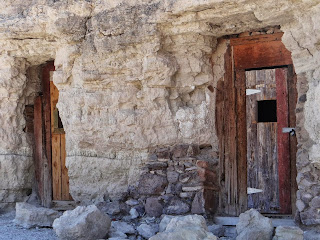We had an opportunity to spend the weekend in the desert birding,hiking and camping. This time it was in Anza-Borrego Desert State Park, 2 hours southeast of Idyllwild.
We have never camped in the desert. For me, it always seemed inherently dangerous...extreme heat, no water, scorpions, tarantulas, rattlesnakes and lots of other creepy crawlies I didn't know about. These signs were a confirmation to be prepared for this new adventure. My top three rules for the weekend - Drink lots of water, wear sunscreen and keep the tent zipped at all times. I should have added no hiking in the middle of the day..
Drinking water is definitely the number one rule. Just looking at this cracked earth will make you thirsty.
Upon arrival, we hiked on the popular Palm Canyon Oasis trail. We were the only hikers probably since we chose the middle of the day to hike.
The spring that normally flows was nearly nonexistent. It continues to amaze me how plants and animals have been able to adapt to this harsh environment.
Most of the wildlife including the Bighorn sheep seek refuge during the
hottest part of the day. This Rock Wren seemed oblivious to the heat as it sang from his perch.
Getting up early before everyone else in the campground to go birdwatching has its advantages - Great Horned owls hooting, beautiful sunrises and shooting stars.
This particular area of the desert is perfect habitat for the rarely seen desert bird, LeConte's Thrasher. Thanks to Kurt, our expert workshop leader, we found one.
The surrounding sand was perfect for capturing tracks and for seeing the homes of burrowing desert dwellers. A story unfolded as to who wandered through the area before we arrived....foxes, badgers, scorpions, lizards,desert tortoises, rabbits...
These x shaped tracks belong to the roadrunner, icon of the southwestern deserts.
Seeing the tracks gave me hope that we would discover this extremely fast, hunting bird. Before the day ended, we caught a glimpse of one before it ran off in pursuit of lunch.
On Labor Day, we saw a magnificent soaring Bald Eagle near our home in Idyllwild. Unable to get a photo, I returned to the lake numerous times for weeks for another sighting but was not successful.
While visiting a lake near the desert, a Bald Eagle flew over our heads with a freshly caught fish in his talons. Not seen in this photo is a Red-tailed Hawk in pursuit hoping the eagle will drop his fish.
Finally, sometimes strange things can appear in the desert like this mysterious frog in the sand...especially, if you are with someone who likes to play tricks on you.


















































